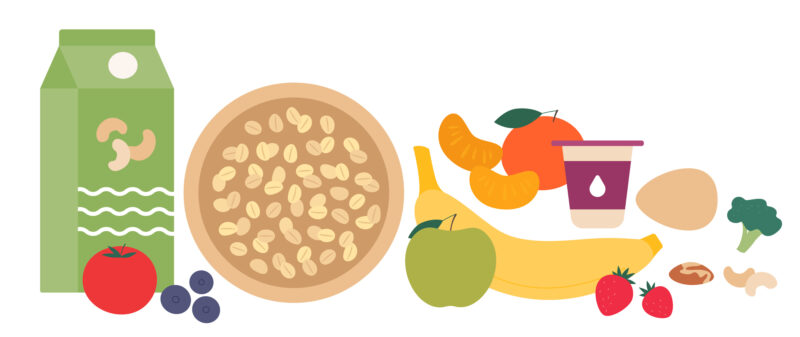
Dietetics
This leaflet is to provide you with guidance and information to help support your decisions. Diabetes is a lifelong condition. It is caused by the body losing the ability to produce insulin, not producing enough insulin or the insulin not being used effectively.
Insulin is a hormone which is produced by an organ called the pancreas. It is used to carry the glucose from our blood to our muscles and organs to provide them with energy.
Glucose is produced when the body breaks down carbohydrates (ie sugars and starches) which come from everyday foods and drinks.
There are two types of diabetes
- Type 1Where the pancreas has stopped making insulin. This type of diabetes is controlled with a combination of dietary treatment and insulin.
Type 2
Where some insulin is still being produced but it does not work properly. This type of diabetes can be controlled through dietary treatment alone OR with a combination of dietary treatment, tablets, and in some cases insulin
Having diabetes may mean you need to adapt your eating habits, but it does not mean that your intake will be restrictive.
The following information is for patients with Type 1 diabetes
Carbohydrate is the nutrient which will have the greatest effect on blood glucose levels.
The following information will help you to understand how you can adapt your diet and maintain good blood glucose control. If you need further advice, please speak to your Dietitian.
Carbohydrates
Misleading messages in the media and differing opinions on carbohydrates has made it hard to understand what they are, which types are best and how much to eat.
Carbohydrate foods provide us with energy. When consumed, they will all be broken down into glucose. Glucose is an essential fuel for our body and brain.
There are 2 main types of carbohydrate. Both types of carbohydrate are broken down into glucose which will increase your blood glucose levels. The portion size and type of carbohydrate will affect how quickly this happens.
Sugary, fast acting or simple
Sugars are added to foods and are often seen on ingredients list as glucose, invert syrup, sucrose or honey.

You need to limit your intake of sugar and sugary foods as this form of carbohydrate is readily available and will increase your blood glucose more quickly.
Natural sugars found in fruit (fructose) and some dairy products (lactose) are more slowly released and will therefore not increase your blood glucose rapidly.
Starchy, slow release or complex
This group of carbohydrates are broken down into glucose more slowly, releasing energy over a longer period of time. They should be included at each meal time. Your Dietitian will be able to provide individual advice about portion sizes.
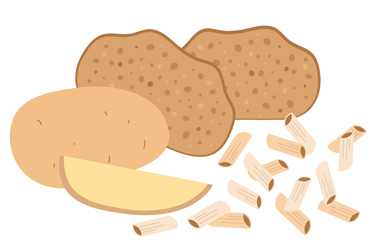
Examples include bread, pasta, chapattis, potatoes, yam, noodles, rice and cereals.
Once you start to get more confident managing your Type 1 diabetes your healthcare team may suggest introducing carbohydrate counting. If you would like more information, please discuss it with your Diabetes Nurse or Dietitian.
| Sugary, fast acting or simple | Starchy, slow release or complex |
|---|---|
| Glucose, sugar or sucrose | Bread or bread rolls |
| Dextrose | Flour |
| Honey | Crackers |
| Syrup | Wraps |
| Treacle | Chapatti or roti |
| Chocolates | Breakfast cereals |
| Sweets | Oats |
| Cakes | Rice |
| Biscuits | Pasta |
| Fruit juice | Noodles |
| Dried fruit | Couscous |
| Tinned fruit (in syrup) | Potatoes |
| Full sugar fizzy drinks | Pastry |
| Fruit yoghurt | Pancakes |
| Crumpets | |
| Fresh fruit | |
| Tinned fruit (in juice) | |
| Milk | |
| Plain yoghurt |
The glycaemic index (GI) is a scale of how quickly a carbohydrate food or drink will affect blood glucose levels. Some starchy carbohydrates have a high GI meaning they are absorbed more quickly. High GI foods are not necessarily unhealthy and not all low GI foods are healthy therefore using the GI to assess if a food is healthy can be misleading.
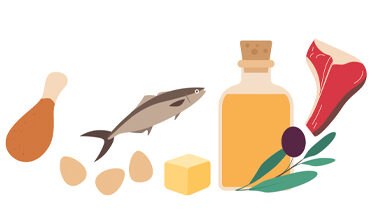
Very little or no carbohydrate foods
Foods which are mainly protein or fat have no effect on blood glucose levels.
Examples include:
| Protein | Fat |
|---|---|
| Meat | Butter or margarine |
| Fish | Oil |
| Eggs | Cream |
| Cheese | Mayonnaise |
Some foods contain a very small amount of carbohydrate but do not affect blood glucose levels. These include:
- Vegetables and salad
- Lentil, beans and pulses
Nuts
Sweetners
It might be helpful to use alternative sweeteners rather than sugar. These include aspartame, saccharine, sucralose, stevia and are found in products such as: Candarel, Sweetex, Splenda, Truvia. Diet or zero fizzy drinks and sugar free or no added sugar squashes also contain these sweeteners so won’t affect your blood glucose level.
Products such as sugar free mints, sweets and chewing gum contain sweeteners such as: sorbitol and xylitol. These will not affect your blood glucose levels but may have a laxative affect if taken in large quantities. These are also found specialist diabetic products which should be avoided.
Hypoglycemia
When your blood glucose level falls too low (below 4.0mmol/litre) this is classed as hypoglycaemia (also known as a hypo). It may happen if:
- You have delayed or missed a meal
- You have not eaten enough carbohydrate at a meal
- You have exercised more than usual, for example, housework, gardening, dancing etc.
- You have taken too much insulin
- The weather is hot
- You are stressed
- You have consumed alcohol
The symptoms of hypos vary in individuals, but you will learn to recognise your own warning signs. The main signs are shaking, sweating, dizziness, blurred vision and becoming irritable or bad tempered.
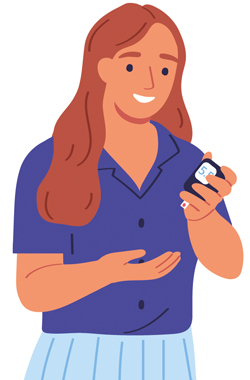
If you have any of these symptoms check your blood glucose level. If it is below 4.0mmol/l then take a form of rapid acting carbohydrate such as:
- 4 to 5 Glucose tablets
- 150 to 200ml Full sugar fizzy drinks
- 3 to 4 Jelly babies
- 200ml Fruit juice
If your blood glucose does not rise to within the normal range in 10 minutes then repeat above treatment and re-test. Please note that this should ideally be a finger-prick blood glucose test as a sensor glucose may have a delay.
Try to prevent hypos by eating regularly and taking the correct dose of insulin and at the correct time.
If possible identify why your hypo has occurred in order to prevent future problems.
Alcohol
The recommended safe maximum intake of alcohol is 2-3 units per day and you should have at least 2 alcohol free days per week.
Remember! Alcohol can make you more prone to hypoglycaemia and if you have too much it may be more difficult to recognise the signs and treat it properly.
- Eat something carbohydrate based before and after drinking alcohol. For example, a sandwich, breakfast cereal, or chips on your way home!
- Tell the people you are with that you have Diabetes and carry ID.
- Always ensure that you have treatment for hypoglycaemia with you.
For more information on alcohol and Type 1 Diabetes, please visit the following websites:
Healthy eating
It is important that you aim to have a well-balanced diet.
Top 10 tips for a healthy eating plan
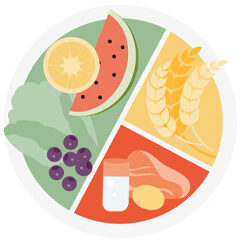
- Always include some form of starchy carbohydrate with your meals.
- Try to cut out or down sugar and sugary foods, such as sweet cakes and biscuits, chocolates and sweets. When you are having these take them after a meal rather than as a snack.
- Aim for 5 portions of fruit and vegetables each day.
- Include plenty of high fibre foods such as fruit, vegetables and wholegrains.
- Take care not to eat too much fat, and watch the type of fat taken. Aim to replace saturated fats with monounsaturated fats such as olive oil, rapeseed oil and avocado.
- Reduce your salt intake to less than 6g per day (less than 3g per day if you have high blood pressure). Avoid adding extra salt to food and limit salty foods such as crisps, salted nuts, ready meals and processed meat.
- Stay within the recommendations for alcohol intake which are no more than 14 units per week with at least 2 alcohol free days.
- Eat regularly without missing meals.
- Aim to get to or maintain your ideal body weight (BMI 18.5 to 25.0kg/m2)
- Avoid any special diabetic foods. These are expensive, often high in fat and calories and may have a laxative effect if taken in large quantities.
Example meal plan
Breakfast
- Cereal (high fibre preferably – such as porridge) with skimmed or semi-skimmed milk and, or
- Granary or seeded bread or toast
- Poly or monounsaturated spread with reduced sugar jam or marmalade Fruit
- Tea or coffee
Lunch
- Sandwiches (granary or seeded bread) with lean meat or tinned fish in spring water or tomato or
- Toast with scrambled egg or
- Jacket potato with baked beans (low sugar) or cottage cheese
- Greek or Natural yoghurt
- Fruit
Evening Meal
- Lean meat or fish with potatoes and vegetables Or
- Spaghetti Bolognese and salad Or
- Chicken curry and boiled rice with vegetables
- Tinned fruit in natural juice or sugar free jelly
Supper
- Cereal, toast or fruit
Ideas for suitable snacks

- A portion of fruit
- 2 plain biscuits – for example: Digestives, rich tea, ginger nut, oat biscuits*
- 2 cracker biscuits – for example: Ryvita, crisp bread, cracker wheat (preferably high fibre varieties)
- Slice of granary or seeded toast
- Tea cake*
- Scone – fruit or plain*
- Crumpet or English muffin*
No carbohydrate snacks
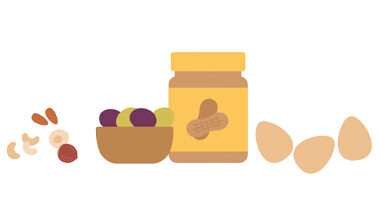
- Vegetable sticks and low fat houmous*
- Low fat cheese cubes*
- Olives
- Nuts*
- Peanut butter*
- Cherry tomatoes
- Sugar free jelly
- Hard boiled egg
Please note: These foods have a slightly higher fat content, so you should be careful how often you have them, especially if you are watching your weigh
Notes
Contact us
If you require further information, please contact us on:
- Dietetics and Nutrition Dept – James Cook University, Middlesbrough, TS4 3BW
Telephone: 01642 854777 or Email: [email protected] - Community Dietetics – Langbaurgh House, Guisborough, TS14 7AA
Telephone: 01642 944 455 or Email: [email protected] - Dietetics and Nutrition Dept – Friarage Hospital, Northallerton, DL6 1JG
- Telephone: 01609 762012 or Email: [email protected]
Patient experience
South Tees Hospitals NHS Foundation Trust would like your feedback. If you wish to share your experience about your care and treatment or on behalf of a patient, please contact The Patient Experience Department who will advise you on how best to do this.
This service is based at The James Cook University Hospital but also covers the Friarage Hospital in Northallerton, our community hospitals and community health services.
To ensure we meet your communication needs please inform the patient experience department of any special requirements, for example; braille or large print by emailing: [email protected]